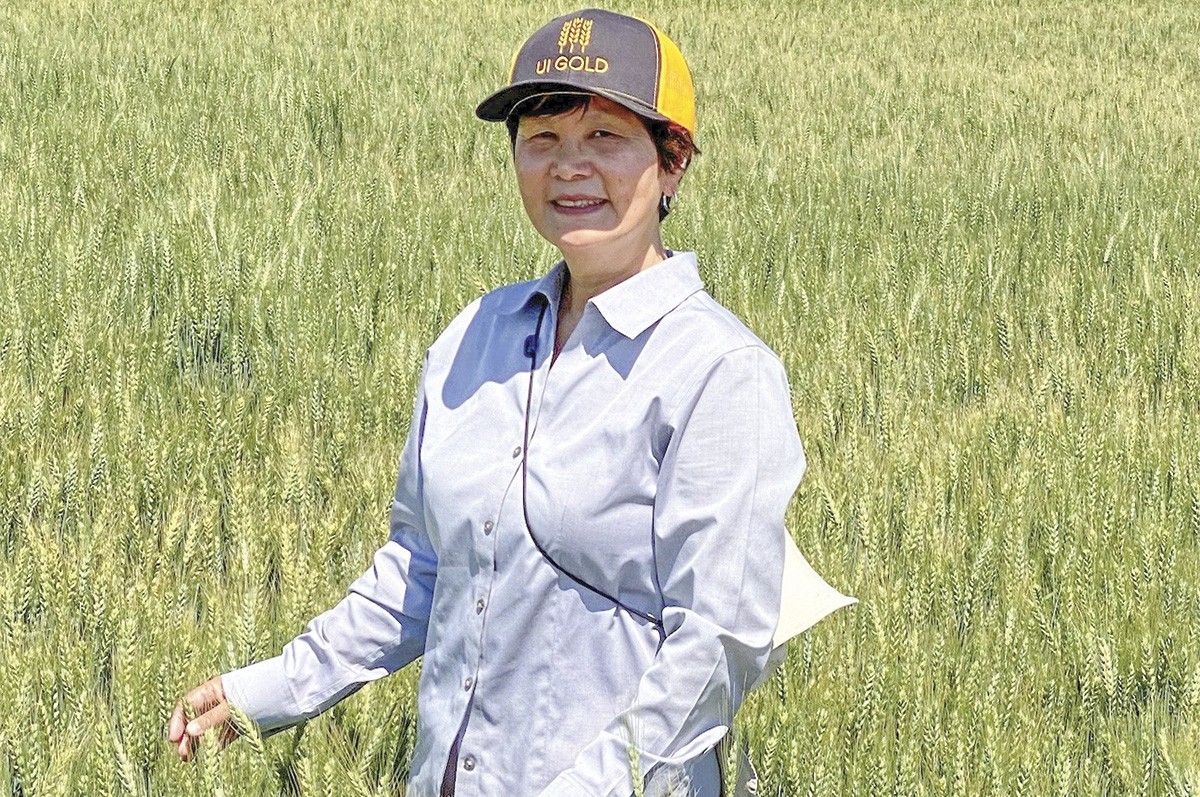In southeast Idaho, the hard white spring wheat (HWS) that reigns supreme is Dayn, a widely grown variety released by Washington State University in 2018. However, a new variety known as UI Gold may soon be giving it a run for its money.
“UI Gold has equivalent or higher grain yields [than Dayn],” says Dr. Jianli Chen of the University of Idaho (U of I) Aberdeen Research and Extension Center. Chen is the breeder of the new variety. The unique improvement, she says, is in the end-use quality. “Overall bread-making quality improved: protein content and also gluten strength and bread volume.”
Dayn’s end-use qualities can fall short of the mark, both in terms of baking quality and flour yield. This somewhat limits the markets willing to accept a Dayn crop. Millers sometimes blend Dayn with another HWS such as UI Platinum (also developed by Chen) to improve flour characteristics. However, this tall, high-protein variety remains popular with producers because of its high yields under a wide range of irrigated and dryland growing conditions. “In the last several years, Dayn has been the variety to beat for yield,” says extension specialist Dr. Juliet Marshall of U of I’s Idaho Falls Research and Extension Center.
So the spring 2025 availability for commercial use of a new variety of HWS wheat for commercial planting that matches Dayn’s yield potential with improved end-use qualities is an exciting prospect for producers, researchers and wheat buyers.
What we know so far
Joel Peck is seed manager at The Arthur Companies, one of the companies licensed to commercialize UI Gold “foundation seed” when it was released in 2022. On the initial 5 acres planted by The Arthur Companies in spring 2023, UI Gold yielded 135 bushels per acre. In 2024, The Arthur Companies contracted with trusted growers for further seed production. With some stripe rust pressure, yields were a bit lower, averaging 125 bushels per acre.
Although UI Gold is resistant to some races of stripe rust, it carries a different gene for resistance than Dayn. This gives the varieties differing susceptibility to different rust races. The infection seen in 2024 affected UI Gold more seriously than Dayn.
“In southeast Idaho irrigated production, usually we have a stripe rust epidemic every five years,” says Chen. “This year was one of the five years. But with this severe epidemic of stripe rust, UI Gold is still doing well.”

In Marshall’s test plots, which are not sprayed for rust, she observed late-season infections causing yield loss in susceptible wheat varieties, including UI Gold but not Dayn. On farms in Peck’s area, even some hard red spring (HRS) wheat varieties that were supposed to be resistant to stripe rust saw losses. Managers maintained yield in seed production fields by spraying for late-onset stripe rust in response to pest updates from the Pacific Northwest. “If in the future, we have a year like this year, we suggest growers apply fungicide one to two times,” says Chen.
“A lot of our growers do not spray for stripe rust in spring wheat,” says Marshall of current practices. However, many area producers are beginning to spray for head blight, and timings for the two applications are compatible.
Ririe Grain and Feed Cooperative is the other company with licensing rights for UI Gold seed. In the areas north and west of Idaho Falls, says manager Lee Andersen, UI Gold producers averaged yields of 138 to 140 bushels per acre in 2023 and 2024.
“It does have some stripe rust susceptibility,” says Andersen. “In the Idaho Falls area, we had fields where we did see some symptoms, but I think the yield was hurt more by the late frost.”
Other considerations for producers are UI Gold’s time to maturity and potential for lodging. In trials, it typically reached heading three days later than Dayn. Higher-elevation growers already tend to eschew Dayn in favor of faster-maturing options with lower yields. However, says Andersen, “We have a lot of experience with Dayn around Ririe, and even in the dryland areas. I feel pretty good about planting UI Gold in those places.”
Meanwhile, one producer observed scattered lodging in 2024. “He said if he were to grow UI Gold again he would use a growth inhibitor on it,” says Peck, “but that’s not a unique issue – some farmers do that for Dayn also.” This limited incidence is unlikely to be a deal-breaker, but it is something to watch, as commercial use spreads.

Dr. Jianli Chen is the breeder of UI Gold, a new variety of hard white spring wheat that has demonstrated high yields and superior end-use qualities in southeast Idaho. Image provided by Jianli Chen.
Future development
Chen expects UI Gold adoption to be mostly restricted to southeast Idaho. In Washington, growers lack the hard white wheat market and prefer varieties with Hessian fly resistance – not a major concern for southeast Idaho.
However, one of the improvement lines now in an early stage in Chen’s lab does contain traits for Hessian fly resistance. Head blight resistance and high fiber are other traits on the table.
And although such a variety is some way out from release, others are always in the works. One that excites Chen, which is also licensed to Ririe Grain and Feed Co-op, is the soft white spring wheat variety UI Warrior. It has so far demonstrated improved yields, stripe rust resistance and good end-use quality. Certified UI Warrior seed will be available to growers in spring 2026.
Playing the long game
Ultimately, the factor that may encourage producers to choose UI Gold over Dayn is its high-end-use quality. While farmers are unlikely to see premiums for that improved quality, they may see long-term benefits. The HWS wheat market is unique to southeast Idaho, with nearly all grain going to the U.S. domestic market. This market demands specific functional end-use characteristics and consequently tends to pay more for HWS wheat than other market classes.
“When the prices are poor and there is an excess of a commodity, you can always sell good-quality product,” says Andersen. “We want the end users to be happy. It may take a little bit of time, but it will improve our reputation in Idaho.”
To that end, both Andersen and Peck are encouraging growers to plant UI Gold on a trial basis in 2025. “I’m not comfortable sending it out on all areas yet,” Andersen says. “It needs to prove itself.”
“After this next year we’ll have some more information,” says Peck. “I would like to see more data and more opinions from farmers.” He will be encouraging producers to put in some split pivots – half Dayn, half UI Gold. “That’s how we’re going to get our best data back,” he says.
“Some varieties take a few years of guys learning how to use it,” says Andersen, citing UI Platinum as an example. After some years of trial and error and falling out of favor with many growers, it is now a dependable variety for many of the growers he works with.
“I know we don’t know everything there is to know about it,” Andersen says. “I don’t want to put any farmers in a position where the whole farm is in UI Gold and then we find the Achilles heel. I don’t think that is going to happen, but we need to be cognizant of it.”





.jpg?t=1687979285&width=640)


